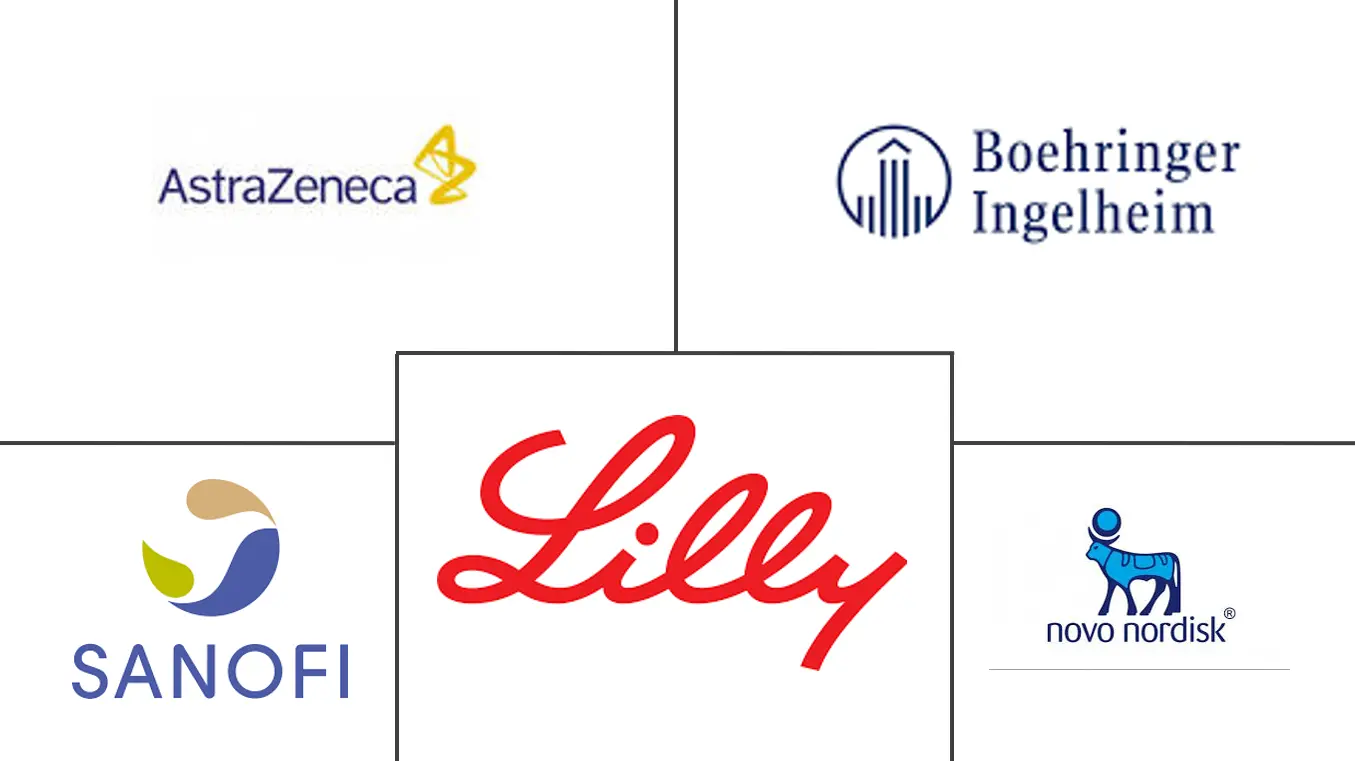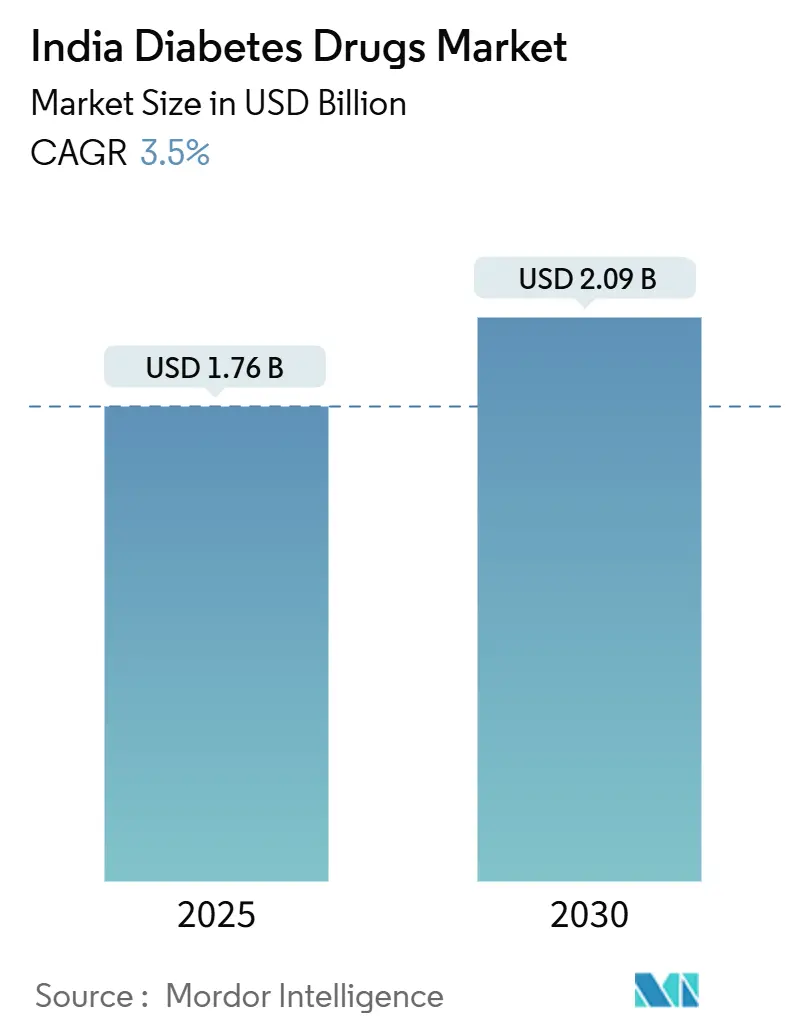
India Diabetes Drugs Market Analysis by Mordor Intelligence
The India Diabetes Drugs Market size is estimated at USD 1.76 billion in 2025, and is expected to reach USD 2.09 billion by 2030, at a CAGR of 3.5% during the forecast period (2025-2030).
According to the study conducted by the Indian Council of Medical Research, India Diabetes (ICMR INDIAB) and published in 2023, the incidence of diabetes stands at 101 million individuals. Diabetes risk factors include race, age, obesity, physical inactivity, a poor diet, behavioral behaviors, genetics, and family history. Controlling blood sugar, blood pressure, and lipid levels can help behavioral behaviors void or postpone the onset of diabetic complications. Diabetes prevention and management pose a significant challenge in India due to several issues and barriers, including a lack of a multisectoral approach, surveillance data, awareness of diabetes, its risk factors and complications, access to health care settings, access to affordable medicines, and so on.
This increase in the use of diabetes medications in India can be attributed to several factors. Firstly, there has been a growing awareness about diabetes and its complications among the general population, leading to more people seeking medical help and treatment for the condition. Additionally, advancements in diabetes drug treatments have made it easier for healthcare providers to manage the disease effectively.
The availability of a wide range of diabetes medications, including oral medications, insulin injections, and newer classes of drugs such as SGLT-2 inhibitors and GLP-1 receptor agonists, has provided healthcare providers with more options to tailor treatment plans to individual patient needs. This has resulted in better glycemic control and improved outcomes for many diabetic patients.
Furthermore, the increasing prevalence of diabetes in India has also led to a greater emphasis on preventive measures and early intervention, prompting more people to seek medical advice and start treatment at an earlier stage of the disease. This proactive approach has helped to reduce the burden of diabetes-related complications and improve the overall quality of life for diabetic individuals in India.
Overall, the rise in the use of diabetes medications in India is a positive development that reflects the growing awareness and understanding of diabetes as a chronic disease that requires ongoing management and treatment. With continued advancements in diabetes drug treatments and increased access to healthcare services, the diabetic population in India can look forward to better outcomes and improved quality of life in the years to come.
India Diabetes Drugs Market Trends and Insights
Oral-Anti Diabetes Drugs Segment is Having the Highest Market Share in the Current Year
Diabetes is a disorder for which there is no cure. With the present arsenal, it is an illness that impacts us for the rest of patients' lives. Individuals face a significant financial, social, and emotional burden beginning at 30 and continuing into their 90s. According to all current guidelines in India, metformin should be the first option among oral antidiabetic medicines at the outset of diabetes.
However, a review of the literature from around the world finds that metformin is used in various ways in the early stages of diabetes. Sharma et al. found a changing trend in 55% of metformin-treated individuals. The fraction of individuals on metformin remains stable from 0 to 20 years of diabetes.
The proportion of sulfonylurea and dipeptidyl peptidase-4 inhibitors (DPP4i) increases from 23.12% and 22.5% in 0-5 years of diabetes to 70.77% and 60% in 10-15 years of diabetes. Following that, the proportion of sulfonylurea and DPP4i remains constant. As the use of sulfonylureas and DPP4i reaches a plateau, the use of insulin and sodium/glucose cotransporter 2 inhibitors increases. From 5 to 10 years of diabetes duration to 20+ years of diabetes duration, the proportion of alpha-glucosidase inhibitors increases somewhat. Thiazolidinediones and glucagon-like peptide-1 receptor agonists have a small proportion in contemporary practice and the given patient population.
Through the Indian government's encouragement, the usage of drugs increased over the forecast period.
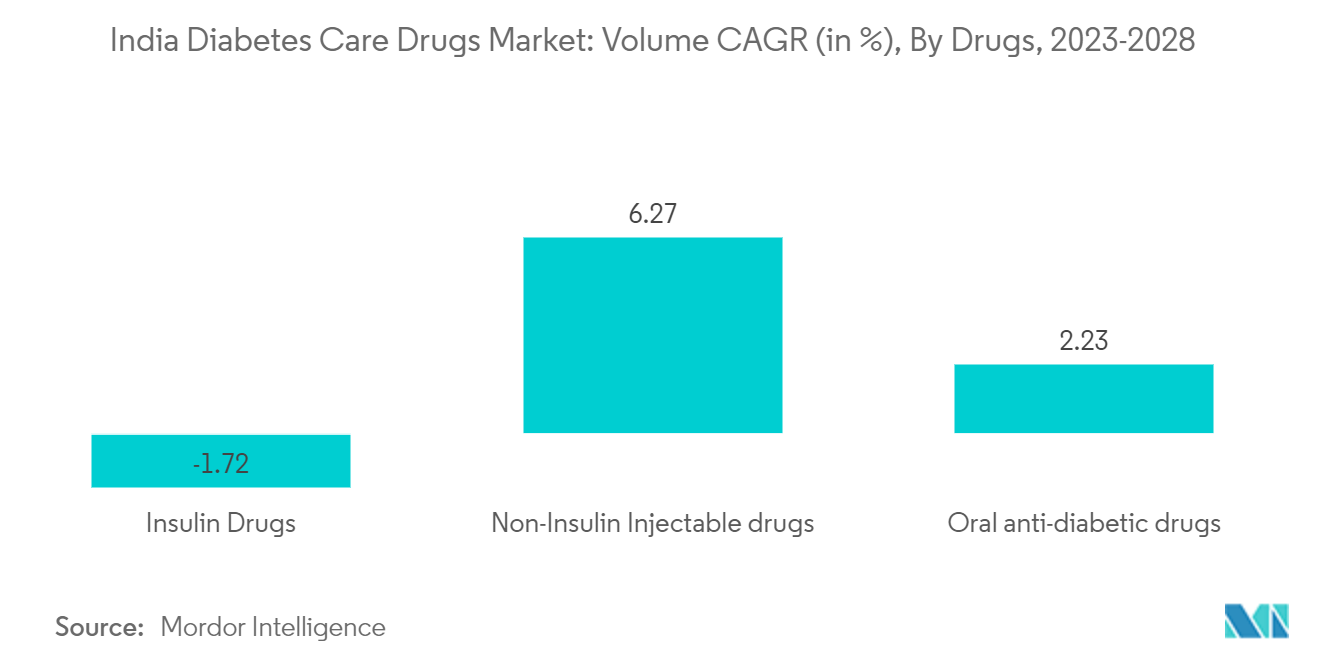
The rising prevalence of diabetes in India is boosting the country's diabetes drugs market.
People living in cities and metropolitan regions in India are more likely than ever before to get diabetes, according to the 2022 assessment. This is due, in part, to cities encouraging a lifestyle that might raise a person's BMI (BMI). A greater BMI is a risk factor for diabetes. Rural India is also seeing an increase in type 2 diabetes occurrences. Diabetes is perceived as a "new" ailment in rural places, and public understanding of the condition is poor.
Diabetes cases are several as the country undergoes urbanization, so more people are migrating to larger cities for work. Sedentary living habits are promoted in urbanized regions and cities, which is a risk factor for rising obesity and diabetes. South Asian ancestors' bodies respond differently to sugary and fatty diets than European ancestors' bodies, and as processed Western foods become more popular in India, so does the risk of diabetes.
In India, it is anticipated to exceed 134 million by 2045. Approximately 57% of these people are still undiagnosed. Type 2 diabetes accounts for most behavioral behaviors and can result in multiorgan problems, roughly classified as microvascular and macrovascular complications. These problems are a key cause of increased early morbidity and death in diabetics, resulting in decreased life expectancy and a huge financial load on the Indian healthcare system.
Thus, the above factors are expected to drive the market growth over the forecast period.
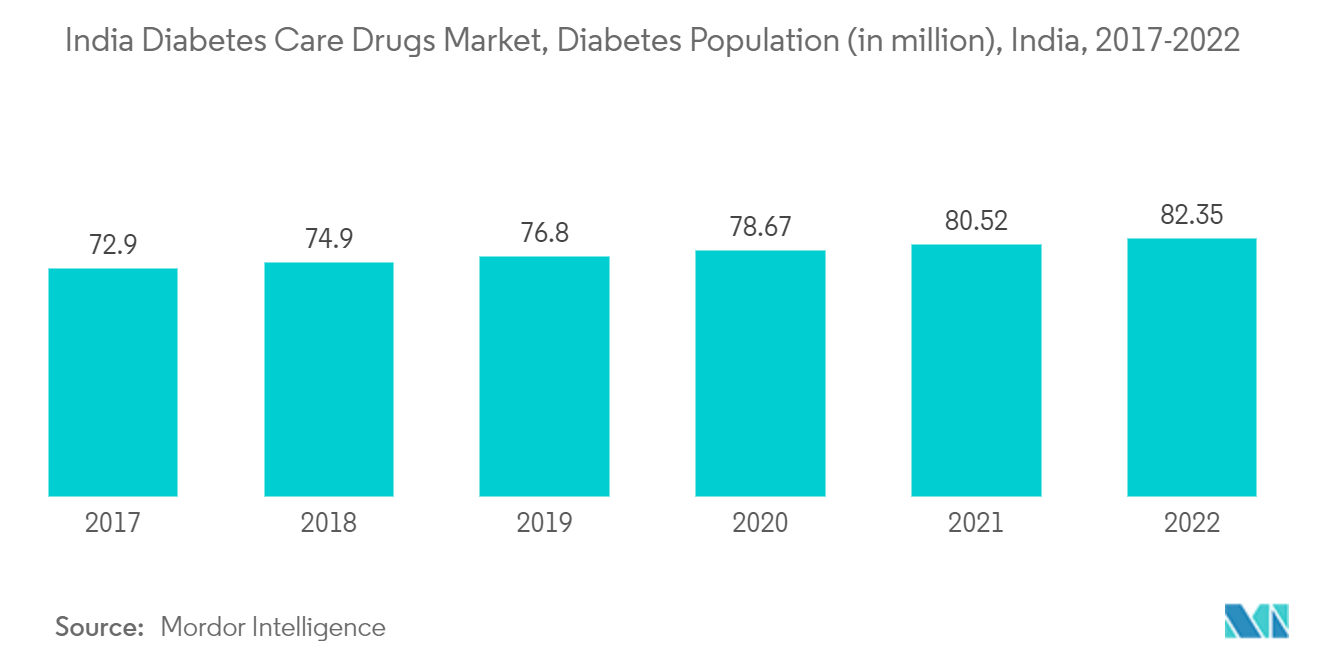
Competitive Landscape
The India Diabetes Drugs Market is moderately fragmented, with few significant and generic players. The insulin drugs and Sglt-2 drugs market are dominated by a few major players, like Novo-Nordisk, Sanofi, AstraZeneca, and Bristol Myers Squibb. The market for oral drugs, like Sulfonylureas and Meglitinides, comprises more generic players. The intensity of competition among the players is high, as each player is striving to develop new drugs and offer them at competitive pricing. Furthermore, to increase their market shares, players are tapping into new markets, especially emerging economies where the demand is very high compared to the supply.
India Diabetes Drugs Industry Leaders
Eli Lilly
Boehringer Ingelheim
Astrazeneca
Sanofi
NovoNordisk
- *Disclaimer: Major Players sorted in no particular order
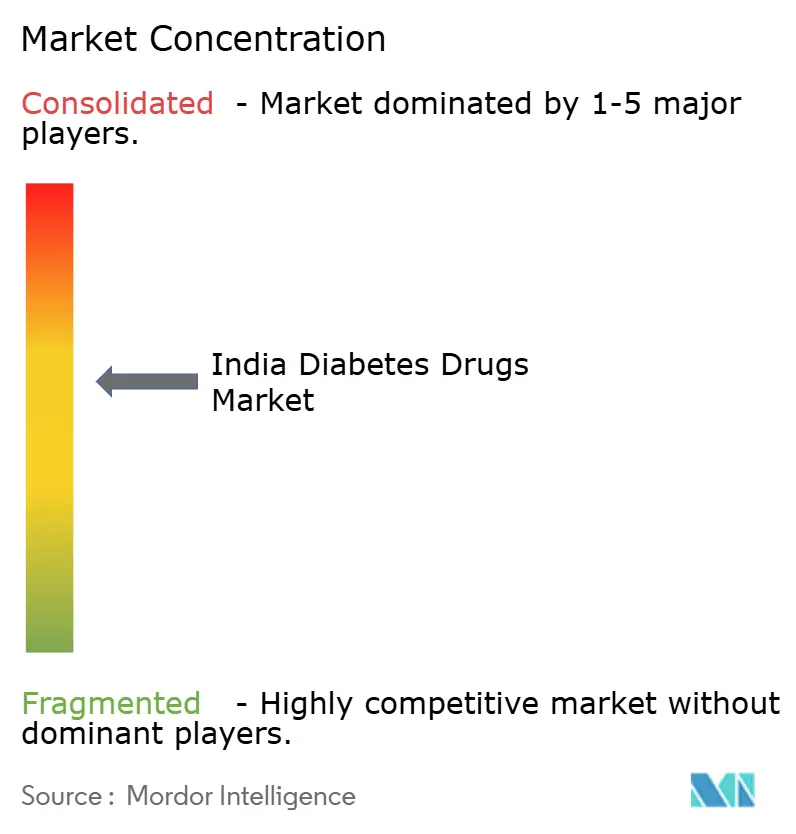
Recent Industry Developments
- March 2023: Sanofi (India) has recently obtained marketing authorization from the Central Drugs Standard Control Organization (CDSCO) for its diabetes medication, Soliqua™. This pre-filled pen drug is specifically designed to enhance glycemic control in adults with type 2 diabetes and obesity who have not achieved sufficient control through oral or injectable therapies. Soliqua™ is administered once daily through pre-filled pens, containing a fixed-ratio combination of insulin glargine and lixisenatide in two different ratios (10-40 and 30-60).
- November 2022: AstraZeneca India gets approval to market the anti-diabetes drug Dapagliflozin. The company said it had received approval from the Central Drugs Standard Control Organization (CDCSCO) for the drug indicated for diabetes patients with chronic kidney disease (CKD).
India Diabetes Drugs Market Report Scope
Diabetes or diabetes mellitus describes a group of metabolic disorders characterized by a high blood sugar level in a person. With diabetes, the body either does not produce enough insulin the body's cells do not respond properly to insulin, or both. India's diabetes care drugs segment market into insulin, oral anti-diabetic drugs, non-insulin injectable drugs, and combination drugs. The report offers the value (in USD) and volume (in units) for the above segments.
| Biguanides | Metformin |
| Alpha-Glucosidase Inhibitors | Alpha-Glucosidase Inhibitors |
| Dopamine D2 receptor agonist | Bromocriptin |
| SGLT-2 inhibitors | Invokana (Canagliflozin) |
| Jardiance (Empagliflozin) | |
| Farxiga/Forxiga (Dapagliflozin) | |
| Suglat (Ipragliflozin) | |
| DPP-4 inhibitors | Onglyza (Saxagliptin) |
| Tradjenta (Linagliptin) | |
| Vipidia/Nesina(Alogliptin) | |
| Galvus (Vildagliptin) | |
| Sulfonylureas | Sulfonylureas |
| Meglitinides | Meglitinides |
| Basal or Long Acting Insulins | Lantus (Insulin Glargine) |
| Levemir (Insulin Detemir) | |
| Toujeo (Insulin Glargine) | |
| Tresiba (Insulin Degludec) | |
| Basaglar (Insulin Glargine) | |
| Bolus or Fast Acting Insulins | NovoRapid/Novolog (Insulin Aspart) |
| Humalog (Insulin Lispro) | |
| Apidra (Insulin Glulisine) | |
| Traditional Human Insulins | Novolin/Actrapid/Insulatard |
| Humulin | |
| Insuman | |
| Biosimilar Insulins | Insulin Glargine Biosimilars |
| Human Insulin Biosimilars |
| Insulin combinations | NovoMix (Biphasic Insulin Aspart) |
| Ryzodeg (Insulin Degludec and Insulin Aspart) | |
| Xultophy (Insulin Degludec and Liraglutide) | |
| Oral Combinations | Janumet (Sitagliptin and Metformin) |
| GLP-1 receptor agonists | Victoza (Liraglutide) |
| Byetta (Exenatide) | |
| Bydureon (Exenatide) | |
| Trulicity (Dulaglutide) | |
| Lyxumia (Lixisenatide) | |
| Amylin Analogue | Symlin (Pramlintide) |
| Oral Anti-diabetic drugs | Biguanides | Metformin |
| Alpha-Glucosidase Inhibitors | Alpha-Glucosidase Inhibitors | |
| Dopamine D2 receptor agonist | Bromocriptin | |
| SGLT-2 inhibitors | Invokana (Canagliflozin) | |
| Jardiance (Empagliflozin) | ||
| Farxiga/Forxiga (Dapagliflozin) | ||
| Suglat (Ipragliflozin) | ||
| DPP-4 inhibitors | Onglyza (Saxagliptin) | |
| Tradjenta (Linagliptin) | ||
| Vipidia/Nesina(Alogliptin) | ||
| Galvus (Vildagliptin) | ||
| Sulfonylureas | Sulfonylureas | |
| Meglitinides | Meglitinides | |
| Insulins | Basal or Long Acting Insulins | Lantus (Insulin Glargine) |
| Levemir (Insulin Detemir) | ||
| Toujeo (Insulin Glargine) | ||
| Tresiba (Insulin Degludec) | ||
| Basaglar (Insulin Glargine) | ||
| Bolus or Fast Acting Insulins | NovoRapid/Novolog (Insulin Aspart) | |
| Humalog (Insulin Lispro) | ||
| Apidra (Insulin Glulisine) | ||
| Traditional Human Insulins | Novolin/Actrapid/Insulatard | |
| Humulin | ||
| Insuman | ||
| Biosimilar Insulins | Insulin Glargine Biosimilars | |
| Human Insulin Biosimilars | ||
| Combination drugs | Insulin combinations | NovoMix (Biphasic Insulin Aspart) |
| Ryzodeg (Insulin Degludec and Insulin Aspart) | ||
| Xultophy (Insulin Degludec and Liraglutide) | ||
| Oral Combinations | Janumet (Sitagliptin and Metformin) | |
| Non-Insulin Injectable drugs | GLP-1 receptor agonists | Victoza (Liraglutide) |
| Byetta (Exenatide) | ||
| Bydureon (Exenatide) | ||
| Trulicity (Dulaglutide) | ||
| Lyxumia (Lixisenatide) | ||
| Amylin Analogue | Symlin (Pramlintide) | |
Key Questions Answered in the Report
How big is the India Diabetes Drugs Market?
The India Diabetes Drugs Market size is expected to reach USD 1.76 billion in 2025 and grow at a CAGR of 3.5% to reach USD 2.09 billion by 2030.
What is the current India Diabetes Drugs Market size?
In 2025, the India Diabetes Drugs Market size is expected to reach USD 1.76 billion.
Who are the key players in India Diabetes Drugs Market?
Eli Lilly, Boehringer Ingelheim, Astrazeneca, Sanofi and NovoNordisk are the major companies operating in the India Diabetes Drugs Market.
What years does this India Diabetes Drugs Market cover, and what was the market size in 2024?
In 2024, the India Diabetes Drugs Market size was estimated at USD 1.70 billion. The report covers the India Diabetes Drugs Market historical market size for years: 2019, 2020, 2021, 2022, 2023 and 2024. The report also forecasts the India Diabetes Drugs Market size for years: 2025, 2026, 2027, 2028, 2029 and 2030.
